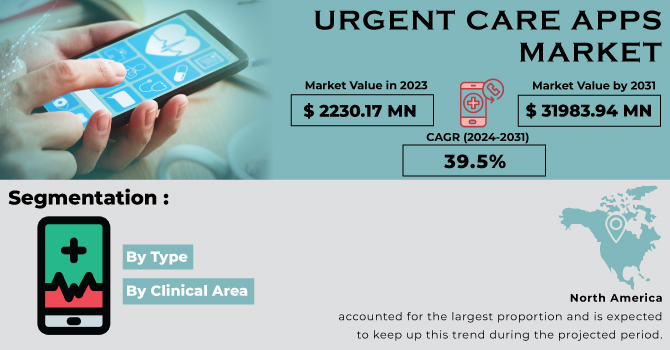The global Urgent Care Apps Market Size, valued at USD 2,230.17 million in 2023, is poised for explosive growth. According to recent projections, the market is expected to reach USD 31,983.94 million by 2031, growing at a compound annual growth rate (CAGR) of 39.5% over the forecast period from 2024 to 2031. This significant growth underscores the increasing adoption of urgent care apps, driven by the need for timely medical assistance, advancements in mobile health technology, and the rising prevalence of chronic diseases.
Understanding Urgent Care Apps
Urgent care apps are mobile applications designed to provide immediate medical assistance, information, and support. These apps connect patients with healthcare professionals, offering services such as virtual consultations, appointment scheduling, and access to medical records. Urgent care apps play a crucial role in bridging the gap between patients and healthcare providers, ensuring timely and efficient medical care.
Get a Free Sample Report @ https://www.snsinsider.com/sample-request/2144
Market Drivers
Several key factors are driving the growth of the urgent care apps market:
- Need for Timely Medical Assistance: The increasing demand for immediate medical assistance, particularly for non-life-threatening conditions, is driving the adoption of urgent care apps. These apps provide quick access to healthcare services, reducing the need for emergency room visits and enhancing patient convenience.
- Advancements in Mobile Health Technology: Continuous advancements in mobile health technology, including telemedicine and remote monitoring, are enhancing the functionality and accessibility of urgent care apps. These innovations are driving market growth by improving the quality and efficiency of healthcare services.
- Rising Prevalence of Chronic Diseases: The growing prevalence of chronic diseases, such as diabetes, cardiovascular diseases, and respiratory conditions, is fueling the demand for urgent care apps. These apps offer patients timely medical advice and support, helping them manage their conditions effectively.
- Increasing Smartphone Penetration: The widespread use of smartphones and the increasing penetration of mobile internet are facilitating the adoption of urgent care apps. The convenience and accessibility of these apps make them a preferred choice for patients seeking immediate medical assistance.
- Focus on Patient-Centered Care: There is a growing emphasis on patient-centered care, which prioritizes the needs and preferences of patients. Urgent care apps empower patients by providing them with control over their healthcare decisions and access to timely medical information.
Challenges and Opportunities
While the urgent care apps market holds significant promise, it also faces several challenges:
- Data Security and Privacy Concerns: Ensuring the security and privacy of patient data is a critical challenge for urgent care apps. Implementing robust security measures and complying with healthcare regulations are essential to address these concerns.
- Integration with Existing Healthcare Systems: Integrating urgent care apps with existing healthcare systems and electronic health records (EHRs) can be complex. Ensuring seamless interoperability is crucial for the effective functioning of these apps.
- Regulatory Compliance: Adhering to healthcare regulations and standards is essential for the success of urgent care apps. Ensuring compliance with regulatory requirements is a significant challenge for app developers and healthcare providers.
Despite these challenges, the market presents numerous opportunities:
- Expansion into Emerging Markets: Expanding the adoption of urgent care apps in emerging markets presents a significant growth opportunity. These regions are experiencing rapid advancements in mobile health technology and increasing demand for accessible healthcare services.
- Development of Innovative Features: Developing innovative features, such as AI-driven diagnostics, personalized health recommendations, and real-time monitoring, can drive market growth. Investment in research and development can lead to the introduction of advanced urgent care apps.
- Collaborations and Partnerships: Collaboration between app developers, healthcare providers, and technology companies can drive innovation and improve the quality of urgent care apps. Strategic partnerships can expand market reach and provide comprehensive healthcare solutions.
Key Market Players
Several key players are driving innovation and growth in the urgent care apps market:
- Allscripts Healthcare Solutions, Inc.: Allscripts offers a comprehensive range of urgent care apps that leverage advanced technologies to enhance patient care and engagement. Their global reach and expertise ensure efficient service delivery.
- Siemens Healthineers AG: Siemens Healthineers provides innovative urgent care apps that leverage cutting-edge technology to enhance patient outcomes. Their commitment to quality and customer satisfaction ensures reliable service delivery.
- Cerner Corporation: Cerner offers a wide range of urgent care apps that improve the efficiency and accessibility of healthcare services. Their focus on research and development drives market growth.
- Medtronic PLC: Medtronic provides advanced urgent care apps that optimize healthcare delivery and improve patient outcomes. Their integrated platform supports value-based care models and enhances service efficiency.
Future Outlook
The future of the urgent care apps market looks promising, with continued advancements in technology and increasing demand for timely medical assistance driving growth. As healthcare organizations strive to improve patient outcomes, reduce healthcare costs, and ensure timely access to medical care, the adoption of urgent care apps is expected to accelerate.
The projected growth to USD 31,983.94 million by 2031 reflects the transformative potential of urgent care apps in modern healthcare systems. With a CAGR of 39.5% over the forecast period, the market is poised for substantial growth, offering innovative solutions that could revolutionize healthcare delivery and patient care.
Conclusion
In conclusion, the urgent care apps market is on a trajectory of significant growth, driven by the need for timely medical assistance, advancements in mobile health technology, rising prevalence of chronic diseases, increasing smartphone penetration, and focus on patient-centered care. While challenges remain, the opportunities for expansion and innovation are vast. The projected market size of USD 31,983.94 million by 2031 underscores the substantial impact urgent care apps are set to have on the future of healthcare delivery and patient care.
Other Reports You May Like:
Microservices in Healthcare Market Size
Clinical Alarm Management Market Size
Clinical Documentation Improvement Market Size
